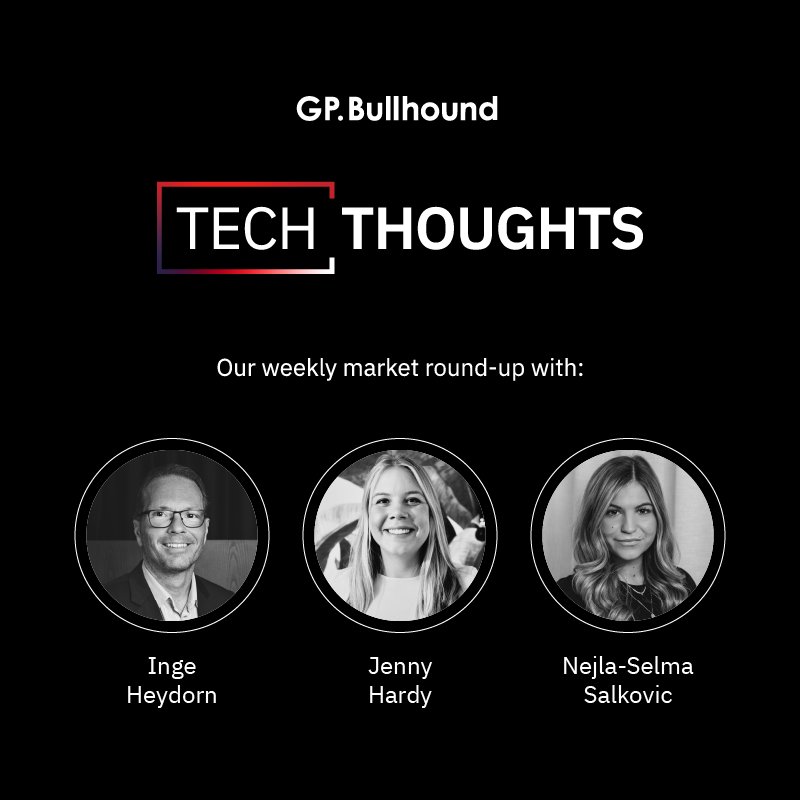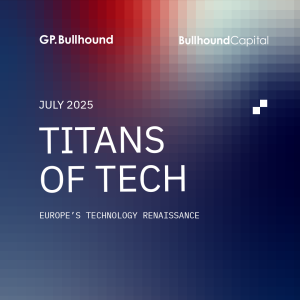Tech Thoughts Newsletter – 10 November 2023.

Market: A volatile end to the week as Fed chair Jerome Powell opened the door to more interest rate rises, compounded by a weak 30-year treasury auction. There’s no getting away from tech broadly correlating to rates. As a reminder, though, on rising interest rates and “cash burn” as it relates to our portfolio, the companies exposed to interest rate rises are those with leveraged balance sheets. The tech sector – and indeed the companies we own – don’t have leverage – they’re cash-rich and cash-generative. Most of our portfolio are either paying a dividend or have buyback programs. Any volatility we’re seeing is around share prices and not the fundamental earnings and returns of the businesses we own – that can certainly create opportunities for us as long-term investors.
Our investment philosophy as a team is to focus on companies’ financial productivity and ability to sustain that over a long time given competitive advantages. This, in turn, leads to a focus on cash flows and return on invested capital of the businesses we own and their ability to compound those (through reinvestment) over time. That focus typically leads us away from the more interest-rate-sensitive parts of the sector.
Portfolio: We made no major changes to the portfolio this week.
OpenAI Dev Day was a reminder why keynotes should be back in person – 10 times more entertaining and exciting than the latest iPhone launch, and nothing beats a live demo.
The highlights:
- OpenAI launched its next-generation model, GPT-4 Turbo, which is 1) smarter (more model parameters and more up-to-date – to April 2023) and 2) cheaper than GPT-4 (3x cheaper for input tokens and 2x cheaper for output tokens).
- GPTs, which, as described by Sam Altman, are “tailored versions of ChatGPT for a specific purpose. You can build a GPT – a customised version of ChatGPT – for almost anything, with instructions, expanded knowledge and actions, and publish it for others to use”.
The comparisons with Apple don’t stop with the keynote excitement being a bit like the early iPhone launches – what Altman was effectively describing was an App store for Chatbots:

We’ve spoken a lot about LLMs and some of the unknowns – how many there will be (with Grok from Twitter/X also launched this week), will there be a winner, will they all be free, and if so, what’s the business model?
In our weekly letter on 29th September, we argued that there’s a significant chance that LLMs end up being commoditised, and that an LLM’s ultimate success is much more likely to come down to distribution and whether they are underlying source codes for other apps. As a result of that argument, we said that for OpenAI to be able to justify its $90bn valuation, it needed to be a consumer app and not just an LLM. This is exactly what Sam Altman presented. While the event was called OpenAI’s “Dev Day”, in reality, it was a product launch at Apple. OpenAI hasn’t quite made the full pivot to being a consumer tech company (which is surely where the upside is), but we watch this space. Still missing is the control of the end device – OpenAI presented an app store for GPTs, which it will control, but the app store will be on phones and PCs which it doesn’t control.
That takes us back to the September rumour that OpenAI is raising money from Softbank’s Masa Son to build the “iPhone of AI” with Jony Ive. How long before we have an OpenAI hardware keynote to watch?
For us in the portfolio, Microsoft’s CEO Satya Nadella was on stage, happy with the partnership. “We love you guys. It’s been fantastic,” he said. It has indeed – remember that OpenAI benefits Microsoft Azure growth in two ways: 1) OpenAI’s API runs on Azure, which means that startups that might previously have defaulted to AWS, are now running on Azure; 2) ChatGPT (OpenAI’s consumer business) has a revenue share agreement (though we don’t know the exact details) with Azure.
It’s helped Microsoft gain share – of the $3bn incremental cloud revenue this quarter, we believe $2bn went to Microsoft.
But it’s also worth noting that OpenAI reducing prices is likely a result of Microsoft’s optimisation of GPUs in its stack and taking those to higher utilisation – it can do that because it can leverage its infrastructure across all of its businesses (ie. Copilot) and OpenAI. It’s a partnership that’s working both ways. Microsoft remains a top 3 position in the portfolio for us.
GPT-4 Turbo getting cheaper is good news overall as it opens up more innovation and experimentation, and, ultimately, means we’ll likely get to those new feasible revenue and business models faster. That will drive more cloud compute and more sustainable investment in AI chips. We own Microsoft, Amazon and Google, which should see more demand within their highly profitable cloud services businesses. We also own Nvidia and AMD, both most obviously downstream of their capex (and TSMC and Semicap, which also benefit).
There is an upside for the enterprise software companies that can effectively connect their own vast proprietary data sets to pre-trained LLMs, and offer AI tools and features to drive ARPU growth.
Finally, on Jony Ive’s “iPhone of AI”, it goes without saying that any mass-adopted AI consumer product, which we assume would be built with some hefty smartphone GPUs, would be very positive for TSMC and Semicap equipment.
Onto newsflow/results:
Another twist in the China/US restrictions – Nvidia “here’s one I made earlier”.
- An unexpected twist as local Chinese news are reporting that Nvidia (owned) are releasing three new China chips to circumvent the new US restrictions (see our letter from 20th October).
- The H20, L20 and L2 are designed to get inside the performance density and peak performance constraints in the new rules. The H20 chip is a derivative of the H200 and is the most relevant to LLM inference.
- They still have full NVLink and PCIe capacity, which means the chips will still be able to be networked together. The chips will supposedly be announced next week and go into mass production by the end of the year, which is an extraordinary turnaround (the A800/H800 launches were almost immediate as Nvidia was effectively able to fuse the interconnect; it’s not clear how much of a redesign this has taken but speaks to their supply chain edge and close relationship with TSMC – which Nvidia was effectively born as a result of in the early 1990s).
- As we said in our last commentary on this issue, we don’t think the US Department of Commerce anticipated (or appreciated) Nvidia’s quick release of the A800 and H800 in 2022. The same might be true for these chips.
- In defence of Nvidia, though, the rules have been set. The new chip designs fall within those rules – it’s no real surprise to us that they continue to want to try to have products going into China, and remember Nvidia’s CUDA ecosystem is highly relevant in China – it’s still a significant moat for them as long as they can supply chips (since CUDA only runs on Nvidia chips) and by having a solution it ensures CUDA remains the dominant framework.
- Huawei’s Ascend GPU is China’s best domestic competitor (built on SMIC’s 7nm), and Huawei’s CANN architecture is a competitor of CUDA. However, it’s still unclear how much supply SMIC will be able to produce at 7nm, and whether it could ever get down to 5nm without EUV tools remains uncertain.
Portfolio view: Good news for Nvidia as forecasts were starting to take down sales into China significantly (it doesn’t impact 2024 given Nvidia is effectively supply constrained, but it supports a counter-argument to those who had assumed there will be an air pocket in 2025 revenue). The H20 chip is a comparable die size and still consumes CoWoS supply, so supply likely remains as constrained as ever.
October semis data – the smartphone is back?
- Nvidia news is a good lead into TSMC’s (owned) October revenue, a new record high of NT $ 243bn, +35% mth/mth from September and up 16% yr/yr. It means the Q4 guide and, indeed, the 2023 full-year guide now look achievable/beatable. It’s benefitting from Nvidia GPU demand filling in 7nm (A100) and 5nm (H100) demand (and presumably now H20), as well as Apple’s 3nm A17 chip demand and now M3.
- Hon Hai reported in-line October numbers – down 4.5% yr/yr but nothing out of line with where we would expect – Apple’s results last week spoke more to driving value through pricing and towards pushing customers towards higher priced options (Pro/Max/memory content) – that’s an upside Hon Hai doesn’t see. We’d also note that while it continues to be the leading assembler of the iPhone, its share is declining (60% in 2023 vs 65-70% in 2022) as Apple continues diversifying its supply chain – outsourcing some of the production to India this year too.
- Largan reported strong October sales +22% yr/yr as it benefits from the periscope lens in iPhone Pro Max and Huawei’s high-end phone.
- Sunny Optical also reported its October shipment, with its main smartphone HCM (camera) and HLS (lens) business growing 23% yr/yr and 18% yr/yr, respectively. Sunny benefits from the iPhone launch and Huawei (and, more broadly, Android market stabilisation). The camera continues to be a standout feature in the smartphone market.
- UMC September sales are still hovering at NT$19bn, up slightly month-on-month, though still tracking 20% below year-ago levels. That speaks to bouncing along the bottom (though hopefully with clearer inventory levels).
- A slightly confusing set of results in this context is from SMIC, which we assumed would benefit from Huawei’s build. Remember, SMIC is building Huawei’s 7nm Mate Pro chip, and we know that device has been selling very well. Still, it reported slightly damp results and gave bleak guidance (given that Huawei will launch a low-end Nova 11 before the end of the year, equipped with another homegrown SMIC chip). The decline in profitability is no real surprise to us – we questioned how profitably SMIC could build 7nm chips (or whether Huawei is paying for it), but we are surprised at the lacklustre sales – which were down 15% yr/yr. SMIC is commenting that they’re seeing destocking at international clients, which contradicts what we’ve heard elsewhere (and indeed what we’ve seen looking through balance sheet numbers). Is SMIC losing share of international clients (perhaps now viewed as too politically sensitive?)
Portfolio view: In semiconductors, we see PC/smartphone bottoming and inventory being cleared, and auto and AI are still seeing strong demand. The only areas of real weakness in the market now are industrial (especially China) and an ongoing server/enterprise inventory correction (which we should be through in Q4/Q1). But with the most significant market (smartphone) turning, we’re set up for good market growth in 2024.
Auto semis still showing strong demand and Chinese auto export volumes
- NXP (owned) reported strong results and guidance and gave an overall positive message with an expectation that each quarter should grow yr/yr next year.
- NXP were the first to see the industrial correction this year (industrial was down 26% in March), and they were the first to act, managing inventory down and under-shipping demand (something that semiconductor businesses haven’t done in prior downcycles); it’s why we think they will be among the first to exit to the correction.
- There are still no signs of any significant correction in auto – management expect it to grow next year even with no auto production growth, given semis content in the drive train and broader vehicle semis content growth (ADAS/Radar).
- As we’ve seen signs of elsewhere, management commented on “an incrementally improving environment” in consumer and mobile vs weak demand in communication infrastructure (mobile base station build-outs).
- Global Foundries also had a positive message in its autos business: “The pricing environment within automotive remains highly constructive as the silicon content functionality and applications across ICE and ACE vehicle architecture continue to grow year-over-year,” and a similar message that consumer is bottoming.
- Finally, October export numbers from China continued to beat expectations – EV sales up 37.5% yr/yr to 767,000. BYD is about half of that volume, and we noted last week BYD is holding November discounts in China. Aggressive price competition continues.
- While we talk a lot about BYD as the biggest EV producer, it’s worth noting that it’s no longer just the low-end/mass market that China EV is carving out. Li Auto, which sells high-range SUVs, reported deliveries of more than 105k in Q3, from 26,500 a year ago.
- Its Li Auto MEGA will start deliveries in February at 500,000 RMB ($70K). While Li Auto doesn’t currently export, it’s a further headache for Global OEMs selling at the higher end into the Chinese market (China, for example, is over a third of BMW’s total deliveries) – not only is there a share shift from international OEMs to Chinese but an accelerated destruction of the combustion engine market as a whole.
- On that note, Zeekr (Geely-owned) released its S1, showing its 001 premium BEV selling 50% more than BMW’s i3 this year. It’s worth considering when global/legacy OEMs (is that what we should call them?) are trying to downplay EV.
- We’ve said previously that China EV is the one bright spot in an otherwise very damp Chinese economic data this year – admittedly helped by continued market subsidies. China’s EV penetration is set to reach close to 40% by year-end, and it will be leading the world in terms of moving away from combustion engine vehicles.
Portfolio view: Auto, along with AI, is a bright spot in semis end demand, with the structural increase in power semis in the move to EV. We continue to think the competitive environment for the global auto manufacturers is challenging – Tesla price reductions speak to that, and we don’t own any auto OEMs (manufacturers). But, there are only a handful of auto semiconductor suppliers, which are designed over long cycles and can maintain pricing power, making it an attractive place to be in the value chain.
Semicap – AI as a revenue driver, China still strong, subsidies continue
- Tokyo Electron reported solid results and upgraded their wafer fab equipment market forecast for 2023 from $70-75bn to $85-90bn. The reason? “Investment by Chinese customers accelerating significantly in mature nodes”. The “significantly” is added vs the prior commentary three months ago.
- We’ve said before that while China is restricted from leading-edge chip manufacturing equipment, it can build for trailing edge nodes, where there is a structural supply shortage globally; these trailing edge semis are critical (in autos, industrial) – clearly borne out of the shortage during the pandemic – and it is only TSMC that has meaningful supply outside of China (Global Foundries is still relatively small in terms of capacity). It’s also an area the US has and continues to ignore (even with the CHIPS act), and after Intel sold off or reused most of its trailing edge fabs decades ago. China building up critical supply not only for its domestic demand but also for the demand of US consumers in the US would put them in a reasonably powerful negotiating position.
- Talking of Chinese spending, back to SMIC, it raised its capex guide to $7.5bn from ~$6bn.
- TEL also calls out AI servers as a driver for the first time, expecting a 31% CAGR from 2003-2027. Servers used in training and inference have a considerable amount more semiconductor content. They are multiples of the cost of standard enterprise servers (~$7k for a standard server, $112k for an inference server, $200k for a training server is our estimate in terms of semi bill of materials). More and faster CPUs and GPUs through AMD and Nvidia, both of which make their chips at TSMC, and further down the chain, are benefitting the semi cap equipment companies, which are all needed to make these leading chips.
- For example, this week Veeco (which makes thin film process equipment for semicap manufacturing) reported a strong beat in the September quarter and spoke of strong growth from orders related to high bandwidth memory (likely Hynix). It estimates that ~10% of its revenue is currently attributable to AI, via GPU chip exposure and HBM DRAM. It says: “We see numerous opportunities in AI overall, split between GPUs, high bandwidth memory, and advanced packaging. And so when – in the totality, we’ve kind of sized that all that business at about 10% of Veeco’s revenue this year. Obviously, as we bring on a second HBM memory provider, that would probably drive incremental.”
- Finally, on semicap, Japan announced it would allocate $13bn in subsidies this year to support its chip manufacturing – we expect some of that will go to TSMC’s fab builds out there.
- Japan was once a semiconductor powerhouse (now it still has strong positions in wafer manufacturing and passive components), but it missed the PC and smartphone boom and fell behind.
- Like the US and Europe, Japan is putting lots of investment around building up its own localised supply.
Portfolio view: Semicap remains a key exposure for us (we own ASML, LAM Research, KLA and Applied Materials). The resilience of the space amid the recent downturn in memory and weakness in logic is something we view as attractive, and we expect multiple structural drivers (geopolitics – including national subsidies, tech leadership and China trailing edge demand) to support growth into 2024/2025. The recent results indicate a shallower trough than prior cycles, which we may now be through.
The chip leadership race continues… 5nm strength at TSMC
- MediaTek announced its new Arm-based Dimensity 9300 chip this week, which followed Qualcomm’s Snapdragon 8 Gen 3 announced last month. Both are built on TSMC’s third-generation 4nm (5nm) process.
- There’s nothing new here except that both companies are sticking carefully to their node-on-node roadmap, and TSMC’s high-performing 5nm node (which is also producing Nvidia’s H100 chips, looks like it will continue to be close to fully utilised.)
Portfolio view: It speaks more broadly to the nature of technology companies, which need to continue to invest and innovate to survive. From a chip perspective, this is characterised by a continued race to get to the leading node or to build chips on the leading node – that, in turn, drives investment at TSMC and benefits the semicap equipment names (which we own). Specifically at 5nm, which we think is fully utilised (Nvidia’s H100 and AMD’s MI300 are both built on it), we believe that TSMC will need to add capacity or repurpose 7nm capacity.
ARM – still question marks on whether its business model can capture it’s actual value
- ARM reported its first results since its IPO – revenue is in line, but the guidance is light.
- Royalty revenue , which ARM makes when products using its chip designs are sold – was down 5% yr/yr – impacted by the ongoing smartphone inventory correction, though acknowledging, along with everyone else in the market, that we look to be at or through the bottom.
- ARM’s battle with the market is to try to be viewed not as a smartphone-only play – that’s a market that isn’t growing anymore – but as an AI play.
- The CEO did speak about “AI R&D supercycle” and that its licensing business benefited from companies taking their licences for AI chips. An interesting comment from the CEO on AI:
Broadly speaking, the way I would think about it is, whenever you’re running one of these AI clients or assistance or agents, it’s going to require a significant uptick in terms of compute capability, both in terms of if there is an in situ accelerator and/or through the CPU complex, keeping in mind that in the client device, when you run these AI agents or whenever you’re running something that’s going to be a co-pilot of some sort, nobody wants to see their battery life suddenly go down 40% in terms of everything that was involved in running the algorithms. So what that means for us in the broad sense is I expect it’s going to be a higher need for more compute capacity. We’ll see more advanced cores, we’ll see larger cores, more v9, which in the end – endgame should mean higher royalty rates for us. That would be our belief going forward in terms of just the megatrend.”
- It’s true – AI and power efficiency are intertwined – and this statement could be read as an Apple pitch, too – if you think about more inference happening locally and on the end device (ChatGPT released their app on the iPhone first), you can argue for Apple as a significant beneficiary (effectively the biggest and best reseller of compute).
- The big issue for ARM is its business model: its royalties relate to chip price, not end device price. That’s why it under-earns its value at Apple (i.e., it doesn’t benefit from Apple’s $1,000 pricing, even though every iPhone is built on ARM).
- Over time, ARM should benefit from chip design becoming more complex, in that more OEMs (like Google for its in-house AI chips) want their customised chips (just like Apple did). The problem is that Apple can effectively choose its price for its developed A17 chip, which is the price that ARM charges a percentage of. It might always make it hard for ARM to capture its actual value.
Portfolio view: For now, we continue to watch ARM from the sidelines, with too many uncertainties (the ones outlined above), little visibility and lots of risk in China, RISC-V competition, and a valuation that’s very hard to frame the downside on.
More signs that cloud optimisation headwinds are ending
- After several quarters of damp results, Datadog beat and raised, and importantly reflected the broad messaging from cloud service providers that the cloud optimisation headwind is starting to be behind us: “We are seeing signs that the cloud optimisation activity from some of our customers may be moderating. As a reminder, last quarter, we discussed a cohort of customers who began optimising about a year ago, and we said that they appear to stabilise their usage growth at the end of Q2. That trend has held for the past several months, with that cohort’s usage remaining stable throughout Q3.”
Portfolio view: We commented on the 27th October after all the big tech/hyperscaler reporting that there were promising signs of stabilisation in cloud spend – that has a broader lead into enterprise software and large deals returning, which we’re exposed to both through the cloud service providers and enterprise software names. We still don’t own consumption-driven names, like Snowflake or Datadog, as we’re still trying to get a better handle on how they fare in a cycle and their competitive positioning in the market (can the cloud service providers move downstream?) – but certainly, Datadog is a positive datapoint this week.
Streaming – will it all lead back to the cable bundle and advertising?
- Disney (not owned) reported this week. Revenue was in line, EPS beat, Disney+ subscriptions are better (and they’re still guiding for streaming to reach profitability in Q4 24). The cost-cutting continues, and they are raising the cost savings target from $5.5bn to $7.5bn, with FCF being guided to get back towards pre-pandemic levels (as a reference, this year will be ~$5bn, and 2018 was ~$10bn).
- Taking a step back, though, Disney has become a pretty complicated equity story. With streaming losing money and their cash cow linear TV businesses succumbing to the structural ongoing cable cutting, the debate now centres around potential restructuring – what assets will they sell/what will they keep?
- We know it is too committed to its parks business (in September it announced it would double the capex in its parks business to $60bn over the next 10 years). In a world with an infinite supply of virtual, doubling down on physical scarcity makes sense. And there’s a very obvious flywheel around Studio IP that fuels that.
- Hulu and Hotstar sit in the “non-core/why-do-they-own-it” bucket (though they’ve exercised the call on buying the remaining Hulu stake from Comcast, that doesn’t mean they can’t sell it down the line).
- And then you have ESPN (and ESPN+), which is still a big profit and FCF driver for Disney – of the total $3bn operating profit in the quarter, $1bn is ESPN. The bulk of this revenue is still affiliate fees, which are now finally declining – these are the fees cable companies pay to Disney to have ESPN in their bundle. Affiliate fees have increased over the last four decades because cable companies could never drop sports as they’d get so many customer complaints. It was an amazing business, and ESPN had extraordinary leverage and pricing power. But that’s been eroded as more content owners (including ESPN themselves with ESPN+ have moved more content online) – Disney going dark on Charter in September spoke to that, and is only going to continue going that way as cable-cutting continues.
- Iger has been straightforward that ESPN will move over the top and on the call spoke to it being the “pre-eminent digital sports platform” – the question is under what business model and what structure (Iger has been open about looking for a potential partner for the business).
- You could argue that to the extent Disney+ is (like Netflix) moving to an advertising model (remember Disney raised prices except in its advertising tier last quarter – presumably to encourage people to churn down to the ad version), ESPN+ becomes core too, since sports advertising has always been such a good business. And bundling Disney+/Hulu and ESPN+ might take us full circle back to what made cable so attractive in the first place (with everyone being forced to pay for sports content whether they like it or not).
- It’s a long-winded way of saying that it’s unclear what Disney will look like in 1-2 years.
Portfolio view: We don’t own Disney. Broadly, we question the long-term returns within the streaming sector – and Disney still wonders what Iger can do in terms of a strategy pivot and more cost-cutting. Streaming still feels like a really tough business, and churn has undoubtedly been structurally higher at maturity than was originally premised – it’s why we ask if there will be a more definitive move to ad-supported (could Netflix/Disney at some point be free?). It’s also hard not to view the presence of Amazon, Apple, YouTube as the big behemoths (who don’t necessarily need to make profits in that category) as a very big negative to the path to profitability and the sustainable level of profitability.
Gaming demand robust but title-driven
- A slew of gaming news this week: the short take is that gaming demand is strong for blockbuster titles. EA reported solid results, with the concerns from losing the FIFA contract subsiding after a strong SPORTS FC.
- TakeTwo saw in-line results, with no significant big releases, and the market is waiting on the GTA release (with the trailer scheduled for December).
- Sony (owned) reported operating profit below consensus, driven predominantly by weakness in its finance business. At the same time, gaming was strong, and will be further helped by its Spiderman and new PS5 console release. In the short term, there is a balance of growth and profitability associated with console sales (which it loses money on), but in the long term, Sony remains the dominant player in the gaming market, having successfully acquired gaming studios over the last two decades, a position which is now hard to displace (even for Microsoft/Activision – despite the FTC views).
- Nintendo (owned) beat and raised its forecast, largely thanks to its latest Mario release and the ongoing strength in Zelda.
Portfolio view: We own Sony, Nintendo and Microsoft (which has now completed its acquisition of Activision). We’re through the gaming Covid market hangover but still focus our exposure on the big franchise title gaming businesses, which have the highest returns on capital given their ability to continue to iterate strong IP.

For enquiries, please contact:
Inge Heydorn, Partner, at inge.heydorn@gpbullhound.com
Jenny Hardy, Portfolio Manager, at jenny.hardy@gpbullhound.com
Nejla-Selma Salkovic, Analyst, at nejla-selma.salkovic@gpbullhound.com
About GP Bullhound
GP Bullhound is a leading technology advisory and investment firm, providing transaction advice and capital to the world’s best entrepreneurs and founders. Founded in 1999 in London and Menlo Park, the firm today has 14 offices spanning Europe, the US and Asia.



